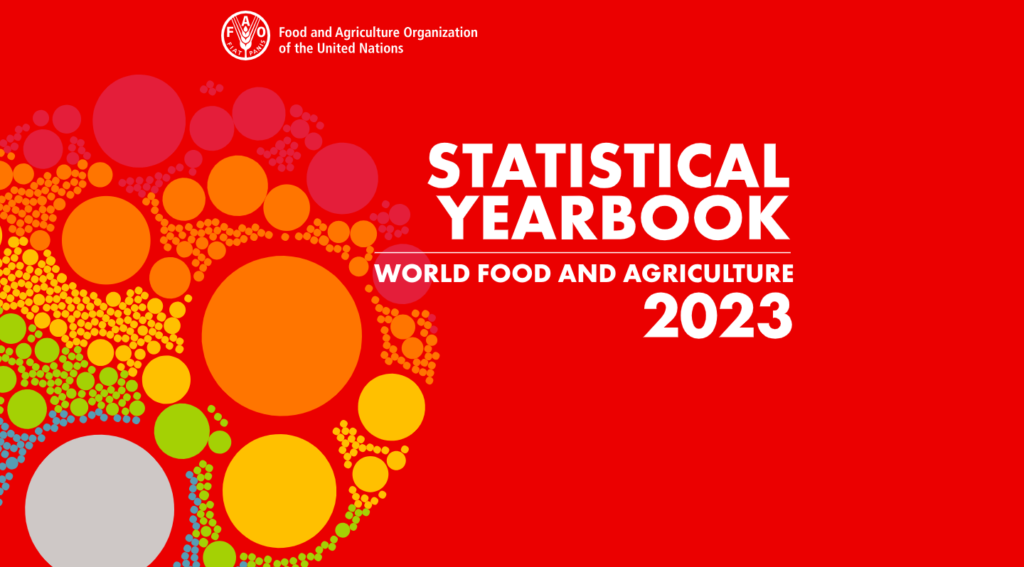FAO Releases 2023 Statistical Yearbook

The Food and Agriculture Organization of the United Nations (FAO) has unveiled its annual Statistical Yearbook, presenting a comprehensive analysis of worldwide agrifood systems and for the first time, shining a light on the repercussions of disasters on agriculture and the cost and accessibility of a nutritious diet.
This publication is a culmination of data compiled by FAO statisticians, delivering a holistic view of the prevailing dynamics within the global food and agricultural domain. The 2023 edition encompasses meticulously organized data distributed across four distinct thematic chapters. These chapters delve into the economic significance of agricultural pursuits, inputs, outputs, factors of production, implications for food security and nutrition, and the environmental footprint of agriculture.
The Statistical Yearbook serves as an essential reference for policymakers, researchers, analysts, and individuals keen on understanding the historical, present, and future trajectories of food and agriculture.
José Rosero Moncayo, Director of FAO’s Statistics Division, underscores the critical role of accurate and timely data in shaping robust policy frameworks. “Timely, accurate and high-quality data and statistics are the cornerstone of solid policy design, where decisions are based on hard evidence, and monitoring and evaluation rely on strong statistical systems,” Moncayo stated in the publication’s foreword.
This year’s release spotlights critical aspects:
Impact of Disasters on Agriculture
The Statistical Yearbook brings to the fore the substantial impact of disasters on agriculture, quantifying the scale of losses incurred due to these events.
Cost and Accessibility of a Healthy Diet
Incorporating recent data from FAOSTAT, this edition showcases insights into the economic accessibility of nutritious foods, highlighting their pivotal role in intertwining food security with nutrition.
Regional Disparities in Food Losses
The disparity in food losses is evident, with sub-Saharan Africa experiencing the highest percentage (almost 20%) in 2021, while Northern America and Europe witnessed the lowest (9%).
Structural Characteristics of the Agricultural Sector
For the first time, users can easily compare structural features across countries and census rounds, deriving valuable insights from agricultural censuses.
Key Facts and Figures
- Disaster Impact: Between 1991 and 2021, disasters resulted in agricultural production losses valued at $3.8 trillion, averaging $123 billion annually or 5% of the global agricultural GDP. Asia, followed by the Americas, Europe, Africa, and Oceania, bore the brunt of these losses.
- Cost of Healthy Diet: In 2021, the global estimate for a healthy diet cost was 3.66 purchasing power parity (PPP) dollars per person per day, surging by 4.3% compared to 2020. Approximately 42% of the global population (over 3.1 billion people) couldn’t afford a nutritious diet in 2021.
- Agricultural Contribution: Agriculture, forestry, and fishing contributed $3.7 trillion to the global economy in 2021, marking an 84% real-term growth since 2000. Asia was the primary contributor, accounting for 65% of this value.
- Employment and Production: Agriculture engaged 27% of the global workforce in 2021, a decrease from 40% in 2000. Primary crop production surged by 54% from 2000 to 2021, reaching 9.5 billion tonnes, majorly driven by sugarcane, maize, wheat, and rice.
- Trade and Emissions: Cereals dominated trade, while greenhouse gas emissions from agrifood systems rose by 10% between 2000 and 2021, with farm-gate emissions contributing nearly half.
This publication is just one among FAO’s series of statistical tools and publications. The freely accessible FAOSTAT platform encompasses an extensive statistical database on food and agriculture, comprising approximately 20,000 indicators across more than 245 countries and territories, with an annual viewership of around 2 million.
You can access the digital version of he report here.


Responses